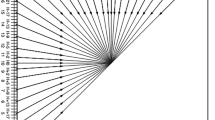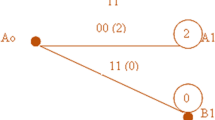Abstract
The Distributed Video Coding with correlated side information for Quarter Common Interface Format (QCIF) was considered for the implementation presented in this paper. The size of the QCIF video was used to develop the Short length progressive Edge Growth codes. A novel pilot symbol based rate compatible code with same Bipartite graph for all rates is proposed. The pilot symbol algorithm makes the computation of the punctured nodes deterministic and one time process. The insertion of pilot symbols converts the parallel virtual channel to a uniform channel, thereby improves the decoding performance. The proposed solution reduces the complexity of the encoder by 25 % and decoder by a factor of 20–40 %. The performance analysis is also done for non-uniform sources as most of the practical data falls into non-uniform distribution.












Similar content being viewed by others
References
Ostermann, J., Bormans, J., List, P., Marpe, D., Narroschke, M., Pereira, F., et al. (2004). Video coding with H.264/AVC: Tools, performance, and complexity. IEEE Circuits and System Magazine, 4(1), 7–28.
Pradhan, S., & Ramchandran, K. (2003). Distributed source coding using syndromes (DISCUS): Design and construction. IEEE Transactions on Information Theory, 49(3), 626–643.
Girod, B., Aaron, A., Rane, S., & Rebollo-Monedero, D. (2005). Distributed video coding. Proceedings of the IEEE, 93(1), 71–83.
Kilic, I., & Yilmaz, R. (2009). A hybrid video compression based on zero tree wavelet structure. Arabian Journal for Science and Engineering, 34(1B), 184.
Slepian, D., & Wolf, J. (1973). Noiseless coding of information sources. IEEE Transactions on Information Theory, 19(4), 471–480.
Wyner, A., & Ziv, J. (1996). The rate distortion functions for source encoding with side information at the decoder. IEEE Transactions on Information Theory, 22(1), 1–10.
Chen, J., He, D., & Jagmohan, A. (2009). The equivalence between Slepian–Wolf coding and channel coding under density evolution. IEEE Transactions on Communications, 57(9), 2534–2540.
Chen, J., He, D., & Jagmohan, A. (2006). Slepian–Wolf code design via source-channel correspondence. In Proceedings of IEEE international symposium on information theory, Seattle, WA (pp. 2433–2437).
Chung, S.-Y., David Forney, G., Richardson, J., & Rudiger Urbanke, T. J. (2001). On the design of low-density parity-check codes within 0.0045 dB of the Shannon limit. IEEE Communications Letters, 5(2), 58–60.
Luby, M. (2002). LT Codes. In: 43rd IEEE symposium on foundations of computer science.
Lee, D., & Song, H. (2011). A robust luby transform encoding pattern-aware symbol packetization algorithm for video streaming over wireless network. IEEE Transactions on Multimedia, 13(4), 788–796.
Ha, J., Kim, J., & McLaughlin, S. W. (2004). Rate-compatible puncturing of low-density parity-check code. IEEE Transactions on Information Theory, 50(11), 2824–2836.
Ha, J., & McLaughlin, S. W.. (2003). Optimal puncturing of irregular low density parity-check codes. In Proceedings of IEEE international conference on communications, Anchorage, AK (vol. 5, pp. 3110–3114).
Liu, Z., Cheng, S., Liveris, A., & Xiong, Z. (2006). Slepian–Wolf coded nested lattice quantization for Wyner–Ziv coding: High-rate performance analysis and code design. IEEE Transactions on Information Theory, 52(x), 4358–4379.
Qian, X., Stankovi’, V., & Xiong, Z. (2007). Distributed joint source-channel coding of video using Raptor codes. IEEE Journal on Selected Areas in Communication, 25(4), 851–861.
Varodayan, D., Lin, Y.-C., & Girod, B. (2012). Adaptive distributed source coding. IEEE Transactions on Image Processing, 21(5), 2630–2640.
Varodayan, D., Aaron, A., & Girod, B. (2005). Rate-adaptive distributed source coding using low-density parity-check codes. In Proceedings of IEEE 39th Asilomar conference on signal, system and computers (pp. 1203–1207).
Jang, M., Kang, J. W., & Kim, S.-H. (2010). A Design of rate-adaptive LDPC codes for distributed source coding using PEG algorithm. In Proceedings of military communications conference, San Jose, CA (pp. 277–282).
Jiang, J., He, D., & Jagmohan, A. (2007) Rateless Slepian–Wolf coding based on rate adaptive low-density-parity-check codes. In Proceedings of IEEE international symposium on Information theory, Nice, France, Jun 24–29 (pp. 1316–1320).
He, D., Jagmohan, A., Lu, L., & Sheinin, V. (2008). Wyner–Ziv video compression using rateless LDPC codes. In Proceedings of SPIE visual communications and image processing, San Jose, CA, Jan 27–28. doi:10.1117/12.766699.
Pishro-Nik, H., & Fekri, F. (2007). Results on punctured LDPC codes and improved iterative decoding. IEEE Transactions on Information Theory, 53(2), 599–614.
Richardson, T., & Urbanke, R. (2008). Modern coding theory. New York: Cambridge University Press.
Tanner, R. M. (1981). A recursive approach to low complexity codes. IEEE Transactions on Information Theory, 27(5), 533–547.
Liveris, A., Xiong, Z., & Georghiades, C. (2002). Compression of binary sources with side information at the decoder using LDPC codes. IEEE Communications Letters, 6(10), 440–442.
LTHC: LdpcOpt (2001). http://lthcwww.epfl.ch/research/ldpcopt.
Author information
Authors and Affiliations
Corresponding author
Rights and permissions
About this article
Cite this article
Masoodhu Banu, N.M., Sasikumar, S. Pilot Symbol Based Fixed Bipartite Graph Rate Adaptable Codes for Distributed Video Coding. Wireless Pers Commun 79, 1145–1161 (2014). https://doi.org/10.1007/s11277-014-1922-9
Published:
Issue Date:
DOI: https://doi.org/10.1007/s11277-014-1922-9




